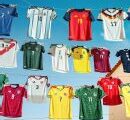
The argument of sports betting vs. online gambling is a fallacy.
As a matter of fact, the online sports betting segment is the nexus in the industry. This vertical is, at the same time, the engine of the overall sports betting market and, more importantly, the main channel for customer acquisition into the high-margin digital gambling ecosystem.
Advertisement
Leaders of the market, such as Flutter Entertainment (FanDuel), Entain (BetMGM), and DraftKings, do not consider them independent businesses. Their portfolio strategy is highly integrated, demonstrating that the future is not about sports or casinos but about leveraging one to feed the other.
Market Sizing and Parallel Growth (2024-2025)
The two industries are growing at a scorching, almost comparable double-digit rate. This co-dependence is supported by similar growth driven by regulatory liberalization and mobile technology.
-
Global Sports Betting Market (Total): This market, comprising all offline (retail) and online sports bets, is valued at approximately $100.9-108.9 billion in 2024.
-
Global Online Gambling Market (iGaming): This market is estimated at $78.7 million in 2024, encompassing digital-only activities such as sports, iCasino, poker, and lottery.
The growth rates of the two markets are expected to be strong, with a compound annual growth rate (CAGR) of about 11% to 11.9%. It is the online sports betting segment that is driving this common direction.
Advertisement
The Funnel Strategy: Debunking the “Vs.”
The most important strategic imperative for all major operators is the funnel. The whole business is explained by this model.
-
Acquisition (Top of Funnel): Sports Betting
The final customer acquisition tool is online sports betting. It is culturally available, mainstream, and the first vertical to be legalized in new markets (such as the U.S.). This is the largest section of the total iGaming market, worth $44.2 billion in 2024, accounting for more than 56% of all online gambling revenue.
Sports betting, however, is a high-volume, low-margin type of business. In the mature markets, the operator’s hold (revenue) is low.
Advertisement
-
Monetization (Bottom of Funnel): iCasino & iGaming
This is where the profit lies. The vertical with the highest margin, the Online Casino (iCasino) (slots, table games), with a value of up to $19.1 billion in 2024, is the powerhouse. It is expanding at an even faster rate than sports betting (12.2% CAGR) and is considerably more profitable to operators.
The strategy is simple:
-
Get a new customer at a high cost through a sportsbook promo.
-
Combine them into a single wallet.
-
Cross-sell them on high-margin iCasino, poker, and lottery products.
The only solution to long-term profitability is the presented sportsbook-as-funnel model. This strategy is specifically verified by companies such as DraftKings, which acquired Jackpocket (lottery), and explicitly states that it is focused on improving cross-selling efficiency in addition to conventional sports betting.
Key Market Drivers and Restraints
The fact that the market is growing exponentially is not a coincidence. It is the combination of two main forces, which are both its strongest limitations at the same time.
Advertisement
1. The Engine: Regulatory Liberalization
It is the one most potent driver. The market is regulated. The point is that growth is not only in the number of new users but also in the Total Addressable Market (TAM) increase with each jurisdiction legalizing the activity.
-
North America: The 2018 United States Supreme Court ruling to strike down PASPA sparked a gold rush as states legalized sports betting into existence one after another.
-
Latin America: The next mega wave is the 2025 liberalization of the Brazilian market, which creates a giant new market but comes with significant entry barriers (such as a 6.1 million-dollar license fee) that favor large multinational players.
2. The Enabler: Technological Penetration
The existence of smartphones, 5G internet, and secure digital payments facilitates the market. The field is mobile-led, and it is estimated that up to 70 percent of revenue comes from mobile platforms. This has enhanced the popularity of in-play (live) betting, transforming passive sport watching into a high-engagement experience.
Advertisement
The Central Restraint: The “Boom-and-Backlash” Cycle
The biggest driver of the industry regulation is also the biggest threat. The visibility of marketing and the speed at which it is saturating the U.S. and Europe are causing an observable social and political backlash. Indeed, issues related to gambling addiction and consumer harm are necessitating the inevitable regulatory crackdown on advertising and promotions, witnessed in the UK and Germany.
And, most recently, in the United States, a massive illegal gambling operation was uncovered by the FBI in October.
Joined the ESPN Inside the NBA crew on the latest surrounding the NBA-Mafia crossover FBI arrests of Portland coach Chauncey Billups and Miami guard Terry Rozier: pic.twitter.com/8CY6fKAQeq
— Shams Charania (@ShamsCharania) October 23, 2025
A Snapshot of the Global Gambling Market
-
Europe: The largest and oldest market with the largest share of revenues. It is, however, experiencing some serious regulatory challenges and advertising bans, and this is a prediction of what a fully grown U.S. market will encounter.
-
North America: It is universally recognized as the fastest-growing market, driven solely by state-by-state U.S. legalization. It is at a high-growth, unsustainable boom-and-bust stage.
-
Asia-Pacific (APAC): The emerging behemoth. Although Europe is the largest by taxable amount, the largest by wagering volume is APAC, indicating an incredible, untapped grey and black market with the greatest long-term potential.
Advertisement
The Future: AI, VR, and the New Standard
The future of both markets will be defined by technology:
-
In-Play (Live) Betting: This is the new standard and has already made a difference in the industry by leveraging high-speed data to turn every moment of a game into a betting opportunity.
-
Artificial Intelligence (AI): The fundamental operational tool is AI. It is applied to personalized marketing (bet recommendations based on individual factors), risk management (changing live odds in real-time), and, more recently, responsible gaming (detecting problem gambling habits).
-
Immersive Experiences (VR/AR): This is the most-mentioned next frontier. The idea is that Virtual Reality will be used to put bettors in a virtual stadium or a VR casino table, and it makes the online convenience more like a land-based social experience.
Strategic Takeaway: An Integrated Future
To the operators, investors, and regulators, the data is evident: online gambling and sports betting are inseparable.
An independent sportsbook is an expensive and low-margin liability in a competitive market. The only way to achieve profitability is through the so-called integrated portfolio. To the investors, the most important benchmark of success is not only the market share but the efficiency of an operator to cross-sell the low-margin sports vertical to the high-margin iGaming products.
Advertisement
The “vs.” is long gone; the future is a single, synchronized, and highly engineered funnel.
The post The 2025 Global Gambling Market: Why ‘Sports Betting vs. Online Gambling’ is the Wrong Debate appeared first on The Lead.









